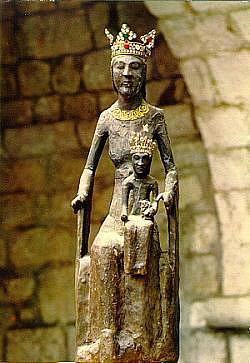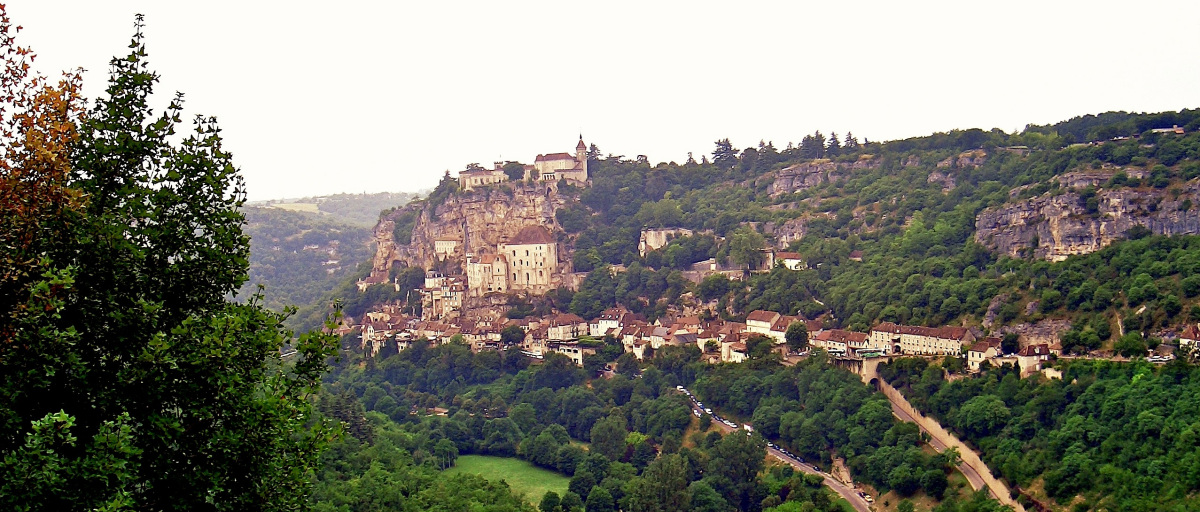La Vierge Noir - the Power of French Medieval Art and Architecture, by Keri Wiederspahn
Here for the first time is a piece by iconographer, Keri Wiederspahn. She will be doing a series of posts about her faith and her work as an icon painter and influences on both. She is on the faculty of Pontifex University, which will offer courses in the Fall. We haven't featured France much on the Way of Beauty to date (perhaps its a reflection of my being English, I don't know), but this certainly helps to redress the balance. Thank you Keri! Here it is:
Beauty leads the way to inspire wonder and holds the key to mystery and a call to transcendence.
By Keri Wiederspahn
Several decades ago, as an unchurched 15-year old drawn to art and already identifying myself as an aspiring artist, I was blessed with a transformative encounter on a trip to the ancient cliff-side village of Rocamadour in the South of France not far from where my parents and I were spending the year on my father's sabbatical in the Dordogne Valley.
Medieval discoveries were now expected daily in our lives in this new land, but this pilgrim experience became something altogether different -- my first encounter with the infinite beauty and love of God received through a sacred aesthetic experience. A true source of theology was manifest in this place of tangible space, color and sculpted form, celebrating the joy and mystery of salvation while revealing an unexpected door of mercy that initiated my early hunger and thirst for God.
With flights of steps worn smooth from the centuries of pilgrimage by kings, bishops, nobles and common folk, various legends and fact intermingle surrounding Rocamadour through St. Amadour who is said to have built the cliff-side chapel in honor of the Blessed Virgin, attributed to also having carved the simple Black Madonna known for its miraculous happenings.
The sense of the Other is profound in this place, rich with the gift of Divine inspiration.

The carved Black Madonna remains cloistered in its chapel to this day, and it was from within the centuries-old resonance of prayer that Christ somehow became real to me for the first time through this most simple presentation of Christ through his Mother.
It turns out that many conversions happened in this humble chapel -- composer Francis Poulenc was one of them, a great talent influenced and mentored by Eric Satie, who after spending extended time in the chapel, dedicated the remainder of his life to spiritual themes in his work, beginning with his Litanies à la Vierge Noire. I did not convert immediately, but the memory of my visit to this place has always been with me and was profoundly influential on my being received into the Church in my mid twenties.
Being an artist and a Catholic convert who has been pursuing traditional Byzantine iconography now for close to a decade, there is life-giving purpose to gaze at the origins of imagery and influence that pave the way towards diving deeper into one's artistic practice. Currently, I'm poised to begin a large icon of Our Lady of Guadelupe, and recognize the moments that remain constant in the flow of beauty that continue to give back and illumine.
Pope Francis shares: "Every form of catechesis would do well to attend to the 'way of beauty' (via pulchritudinis). Every expression of true beauty can be acknowledged as a path leading to an encounter with the Lord Jesus. (Beauty is) a means of touching the human heart and enabling the truth and goodness of the Risen Christ to radiate within it...so a formation in the via pulchritudinis ought to be a part of our effort to pass on the faith."
Listen to Francis Poulenc's Litany for the Black Madonna
https://www.youtube.com/watch?v=4Xu6PuqUJfw
Litanies à la Vierge Noire, Francis Poulenc translation:
Lord, have pity on us.
Jesus Christ, have pity on us.
Jesus Christ, hear us.
Jesus Christ, grant our prayers.
God the Father, creator, have pity on us.
God the Son, redeemer, have pity on us.
God the Holy Spirit, sanctifier, have pity on us.
Holy Virgin Mary, pray for us.
Virgin, queen and patron, pray for us.
Virgin, whom Zacchaeus the tax-collector made us know and love,
Virgin, to whom Zacchaeus or Saint Amadour raised this sanctuary,
Pray for us, pray for us.
Queen of the sanctuary, which Saint Martial consecrated,
and where he celebrated his holy mysteries,
Queen, before whom knelt Saint Louis
Asking of you good fortune for France,
Pray for us, pray for us.
Queen, to whom Roland consecrated his sword, pray for us.
Queen, whose banner won the battles, pray for us.
Queen, whose hand delivered the captives, pray for us.
Our Lady, whose pilgrimage is enriched by special favors,
Our Lady, whom impiety and hate have often wished to destroy,
Our Lady, whom the peoples visit as of old,
Pray for us, pray for us.
May we continue to strengthen our lives through the gifts of beauty
past and present to bear light to Christ, the source of our joy,
beholding and leading us further along the via pulchritudinis.


